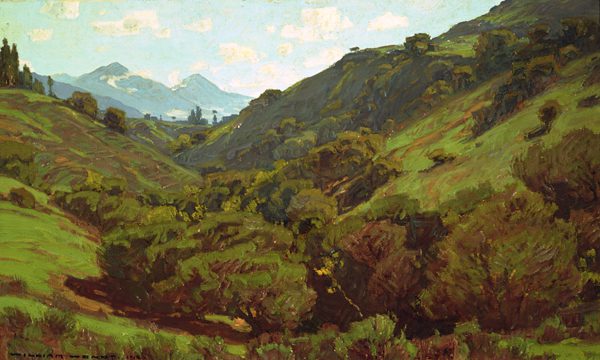Landscape

William Wendt
Landscape
Oil on canvas, 1912
18 x 30 inches
Gift of Nancy D. W. Moure and Joseph L. Moure
1980.125
William Wendt’s Landscape of 1912 is typical of how successfully the artist blended visual strategies associated with the Hudson River school—the epic, distant view rendered with structural precision—with the illuminated palette of impressionism. Wendt shared the belief held by early American painters that evidence of divine plan and purpose was woven into the landscape, and his art is marked by his careful transcription of natural scenery. For Wendt, the facts of Creation were truth. In his Landscape, the largesse and grandeur of California is captured by a succession of overlapping hills receding into a blue-gray distance: this, the artist effectively communicates, is a vast and effulgent landscape. The open, blue sky and the interlocking permutations of green suggest healthfulness and, by extension, optimism.
Wendt also embraced the vitality and sensuality offered by impressionism’s direct transcription of outdoor light and color, as these phenomena were equally true. Landscape’s solid forms are layered with bright, briskly applied strokes derived from his ongoing outdoor study. Not fully academic nor fully impressionistic, William Wendt’s genius lay in his ability to synthesize aspects of both traditional and more contemporary modes of painting, and keep his focus on what he believed to be the role of the artist: to reveal the essential goodness of nature. His single-minded devotion to this task made him one of Southern California’s most popular and influential artists in the first half of the twentieth century, and his legacy continues to resonate into the present time.






